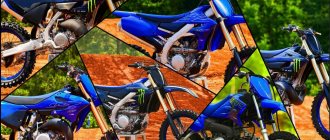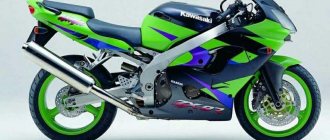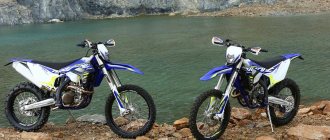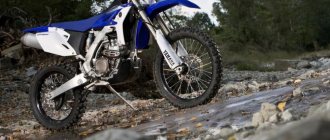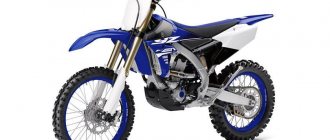| Yamaha YZ250F (2001-2005) | Yamaha YZ250F (2006) | Yamaha YZ250F (2007-2009) |
| Yamaha YZ250F (2010-2013) | Yamaha YZ250F (2014-2018) | Yamaha YZ250F (2019-2020) |
| Yamaha YZ250F (2021) | Yamaha YZ250F (2022+) | Yamaha YZ250F Monster Energy Yamaha Racing Edition (2022) |
Yamaha YZ250F motocross model
appeared in 2001 as a 4-stroke motocross model designed to replace the 2-stroke Yamaha YZ250. It should be noted that this step was taken by the entire Japanese “quartet” of motorcycle manufacturers, the only difference being that 2-stroke motocross motorcycles from Yamaha were so successful that they continue to be produced in parallel with 4-stroke ones and even compete in the same racing class.
The Yamaha YZ250F was based on a 1-cylinder 4-stroke liquid-cooled engine with a volume of 249 cm³, with 5 valves, producing about 42 hp. power and 29 Nm of torque.
In 2006, the model underwent a major update, the main innovation of which was the transition from a steel to an aluminum frame. It was from this moment that the YZ250F model became a full-fledged player in the market of motocross models with an engine capacity of up to 250 cm³.
For 2008, the model receives a new engine that has been further optimized, slightly increasing maximum power and torque characteristics.
For 2010, the Yamaha YZ250F gets a new fork and repositions the engine in the frame to lower the center of gravity and improve handling. Overall optimization allowed us to achieve a record curb weight of 102 kg.
2014 marked the new generation of the Yamaha YZ250F. The motorcycle received a new front fork, a new engine with an injection power system and an increased compression ratio (from 12.5 to 13.5), a 4-valve cylinder head (instead of 5-valve). In 2021, the model received a new front brake disc (diameter increased from 250 to 270 mm).
In 2021, Yamaha again updates the YZ250F, which, in addition to changes in appearance, receives a new engine (compression ratio increases from 13.5 to 13.8), a new rear shock absorber (changed settings) and an electric start.
For 2021, Yamaha has introduced a new generation of the YZ250F. The updated model received a new cylinder head, control unit, intake system, modified frame, new suspension settings and an updated brake system (updated calipers, discs, brake pads, rear disc diameter reduced from 245 to 240 mm).
Yamaha is releasing an updated YZ250F at the end of 2021. The new model received a wider rear wheel (100 → 110 mm), updated graphics and optimized suspension settings.
The Yamaha WR250 enduro series and the Yamaha YZ250FX hard enduro series (available since 2015) were built on the basis of the Yamaha YZ250F.
The main competitors of the Yamaha YZ250F in the class:
- Honda CRF250R
- Kawasaki KX250F
- Suzuki RM-Z250
Brief history of the model
- 2001 - Model
: Yamaha YZ250F (All markets).
Factory designation
: 5NL1, 5NL2, 5NL3, 5NL4.
- 2002 - Model
: Yamaha YZ250F (All markets).
Factory designation
: 5SG1, 5SG2, 5SG3, 5SG4.
- 2003 - Model
: Yamaha YZ250F (All markets).
Factory designation
: 5UL1, 5UL2, 5UL3, 5UL4.
- 2004 - Model
: Yamaha YZ250F (All markets).
Factory designation
: 5XC1, 5XC2, 5XC3, 5XC4.
- 2005 - Model
: Yamaha YZ250F (All markets).
Factory designation
: 5XC5, 5XC6, 5XC7, 5XC8.
- 2006 - Model
: Yamaha YZ250F (All markets).
Factory designation
: 5XC9, 5XCA, 5XCB, 5XCC, 5XCD, 5XCE, 5XCF.
- 2007 - Model
: Yamaha YZ250F (All markets).
Factory designation
: 5XCG, 5XCH, 5XCJ, 5XCK.
- 2008 - Model
: Yamaha YZ250F (All markets).
Factory designation
: 5XCL, 5XCM, 5XCN, 5XCP.
- 2009 - Model
: Yamaha YZ250F (All markets).
Factory designation
: 5XCR, 5XCS, 5XCT, 5XCU.
- 2010 - Model
: Yamaha YZ250F (All markets).
Factory designation
: 17D5, 17D6, 17D7.
- 2011 - Model
: Yamaha YZ250F (All markets).
Factory designation
: 17DD, 17DE, 17DF.
- 2012 - Model
: Yamaha YZ250F (All markets).
Factory designation
: 17D9, 17DA, 17DB.
- 2013 - Model
: Yamaha YZ250F (All markets).
Factory designation
: 17DH, 17DJ, 17DK.
- 2014 - Model
: Yamaha YZ250F (All markets).
Factory designation
: 1SM1, 1SM2, 1SM3.
- 2015 - Model
: Yamaha YZ250F (All markets).
Factory designation
: 1SM5, 1SM6, 1SM7.
- 2016 - Model
: Yamaha YZ250F (All markets).
Factory designation
: 1SM9, 1SMA, 1SMB, 1SMD, 1SMF, 1SMG.
- 2017 - Model
: Yamaha YZ250F (All markets).
Factory designation
: 1SME, 1SMJ, 1SMK.
- 2018 - Model
: Yamaha YZ250F (All markets).
Factory designation
: 1SMM, 1SMN, 1SMP.
- 2019 - Model
: Yamaha YZ250F (All markets).
Factory designation
: YZ250FKL, YZ250FKW.
- 2020 - Model
: Yamaha YZ250F (All Markets).
- 2021 - Model
: Yamaha YZ250F (All Markets).
- 2022 - Model
: Yamaha YZ250F (All Markets).
On the track Yamaha YZ250F
On the track, the YZ250F meets the ergonomic requirements of a modern motocross bike: a smooth seat, a comfortable frame that allows you to grip the bike with your legs, and an adjustable handlebar position. Adding to the comfort of the YZ250F is Yamaha's exclusive fuel tank, which is positioned down and completely enclosed, allowing the rider to literally sit on it without experiencing the slightest discomfort.
In my opinion, the new kick starter placement and shape makes the YZ250F easier to start. Once you start the bike with one gentle push and hit the track, the Yamaha will impress with its ergonomics compared to other mid-sized 250cc motorcycles. Some tank seats feel wrinkled to the touch, while others appear elongated and are more suitable for tall drivers. Yamaha makes compromises and caters to the needs of a wide clientele. And for a driver of about ninety meters, like me, there is room to turn around.
Specifications
Yamaha YZ250F Specifications:
| Model | Yamaha YZ250F |
| Motorcycle type | cross |
| Year of issue | 2001+ |
| Frame | Steel half-duplex – YZ250F (2001-2005) Aluminum half-duplex – YZ250F (2006+) |
| engine's type | 1-cylinder, 4-stroke |
| Working volume | 249 cm³ |
| Bore/Stroke | 77.0 x 53.6 mm |
| Compression ratio | 12.5 – YZ250F (2001-2013) 13.5 – YZ250F (2014-2018) 13.8 – YZ250F (2019+) |
| Cooling | liquid |
| Number of valves per cylinder | DOHC, 5 valves – YZ250F (2001-2013) DOHC, 4 valves – YZ250F (2014+) |
| Fuel supply system | Carburetor, 1x Keihin FCR-MX37 – YZ250F (2001-2013) Injector, 1x 44 mm – YZ250F (2014+) |
| Ignition type | CDI - carburetor versions TCI - injection versions |
| Maximum power | 42.0 hp (30.9 kW) at 10500 rpm – YZ250F (2001-2007) 42.8 hp (31.5 kW) at 10500 rpm – YZ250F (2008-2010) |
| Maximum torque | 28.4 Nm (2.9 kg-m) at 8500 rpm - YZ250F (2001-2007) 29.5 Nm (3.0 kg-m) / 8500 rpm - YZ250F (2008-2010) |
| Clutch | Multi-disc in oil bath, cable drive |
| Transmission | 5-speed |
| type of drive | chain |
| Front tire size | 80/100-21 51M |
| Rear tire size | 100/90-19 57M 110/90-19 62M — 2022+ |
| Front brakes | 1 disc, 250 mm, 2-piston caliper – YZ250F (2001-2015) 1 disc, 270 mm, 2-piston caliper – YZ250F (2016+) |
| Rear brakes | 1 disc, 245 mm, 1-piston caliper 1 disc, 240 mm, 1-piston caliper – YZ250F (2021+) |
| Front suspension | 48mm inverted fork (fully adjustable), 300mm travel – YZ250F (2001-2013) 48mm inverted fork (fully adjustable), 310mm travel – YZ250F (2014+) |
| Rear suspension | Pendulum with monoshock absorber (fully adjustable), travel - 315 mm - YZ250F (2001-2005, 2014-2018) Swingarm with monoshock absorber (fully adjustable), travel - 310 mm - YZ250F (2006-2009) Swingarm with monoshock (fully adjustable), travel - 317 mm - YZ250F (2019+) |
| Motorcycle length | 2165 mm – YZ250F (2001-2005, 2014-2018) 2176 mm – YZ250F (2006) 2160 mm – YZ250F (2007-2013) 2175 mm – YZ250F (2019+) |
| Motorcycle width | 827 mm – YZ250F (2001-2005) 815 mm – YZ250F (2006) 825 mm – YZ250F (2007+) |
| Motorcycle height | 1303 mm – YZ250F (2001-2005, 2010-2013) 1292 mm – YZ250F (2006) 1299 mm – YZ250F (2007-2009) 1280 mm – YZ250F (2014-2018) 1285 mm – YZ250F (2019+) |
| Wheelbase | 1475 mm – YZ250F (2001-2005, 2014+) 1485 mm – YZ250F (2006) 1469 mm – YZ250F (2007-2009) 1466 mm – YZ250F (2010-2013) |
| Seat height | 998 mm – YZ250F (2001-2005) 983 mm – YZ250F (2006) 984 mm – YZ250F (2007-2009) 988 mm – YZ250F (2010-2013) 965 mm – YZ250F (2014-2018) 970 mm – YZ250F (2019+) |
| Minimum ground clearance (clearance) | 382 mm – YZ250F (2001-2005) 369 mm – YZ250F (2006) 370 mm – YZ250F (2007-2009) 375 mm – YZ250F (2010-2013) 325 mm – YZ250F (2014-2018) 335 mm – YZ250F (2019+) |
| Acceleration 0-100 km/h (0-60 mph) | |
| Maximum speed | |
| Gas tank capacity | 8.0 L – YZ250F (2001-2005) 7.0 L – YZ250F (2006-2009) 6.4 L – YZ250F (2010-2013) 6.2 L – YZ250F (2019+) |
| Motorcycle weight (dry) | 93.5 kg – YZ250F (2006) 92.7 kg – YZ250F (2007-2009) |
| Motorcycle weight (curb) | 104.5 kg – YZ250F (2001-2005) 102.0 kg – YZ250F (2010-2013) 105.0 kg – YZ250F (2014-2018) 106.0 kg – YZ250F (2019+) |
Pros of the 2021 Yamaha YZ250FX
- Low fuel level indicator. It's always useful to know that there is enough gasoline left to return.
- Controllability. The YZ250FX is stable and predictable on the road.
- Crankcase protection. Its presence is pleasing, but the design is questionable. For serious off-road driving it would be worth strengthening, but it’s good that there is at least some of it.
- Engine. Yamaha has great motors - especially with the new maps.
- Fan. No, it is not included in stock, but it is available as an option and is connected without modifications, directly into the standard wiring.
- Stuffing box chain. A pleasant plus for those who spend a lot of time traveling.
- Side stand. Extremely convenient when you want to stop and admire the views. But it would be nice if it folded more deeply and was equipped with a rubber tie for racing.
Reviews
Yamaha YZ250F reviews:
The suspension of the updated Yamaha YZ250F may not seem the softest at first; the usual inverted telescopic fork is actually completely inherited from its predecessor due to its high reliability. At the rear, the designers also installed the KYB monoshock absorber, which has repeatedly proven its quality, working in tandem with an aluminum pendulum. The suspension can be easily adjusted, and the shock absorber travel of 300 mm at the front and 312 mm at the rear is more than enough to handle any bumps and hard landings.
The brakes are great too, with a twin-piston caliper up front gripping the 250mm disc firmly and responding instantly to the handlebar lever. Her effort is more than enough to stop a motorcycle weighing more than 100 kilograms in a split second. To assist the front brake, the rear wheel has another 245mm disc with a single-piston caliper. The brakes do their job well on any type of surface, but that's also thanks to the Bridgestone M404-A tires up front and M403 tires at the rear, which bite into dirt, gravel and asphalt equally well.
The Yamaha YZ250F is not a cheap cross bike; its price tag in dealer showrooms starts at over 360,000 rubles. But this motorcycle is worth the money, especially if you buy it not for weekend rides, but to write a history of victories. Such a goal justifies any means.
Cons of the 2021 Yamaha YZ250FX
- Weight. The YZ250FX is worth going on a diet, but that will only be possible when the YZ250F loses serious weight.
- Rear wing. When you put the motorcycle on a stand, the fender tends to break or cut off your fingers.
- Dimensions. The YZ250FX is big and wide. This is especially noticeable compared to other cross-country 250s.
- Grips. It's time for all manufacturers to switch to quick releases.
- Clutch. It is equipped with 20% softer springs, so the lever is squeezed gently. Only then will they still have to be replaced with more rigid ones.
- Compression smoothing controls. You can't reach them, the steering wheel is in the way.
- ECU maps. Both stock YZ250FX cards aren't very good. Engineers should turn to serious testers and work together to make the maps more interesting.
- Tires. Not bad, but not for hard ground. They lose checkers on rocks or even asphalt.
- Airbox. Not the best design. The flat foam filter gets dirty quickly and dirt accumulates on the back of the airbox. And in the forest, the plastic radiator rake leaves, flowers and chafers directly into the airbox. In addition, the intake sounds almost louder than the exhaust.
- Lever protection. Any off-road route includes bushes and trees. Therefore, lever protection is not a luxury, but a necessity.
The power of the engine is genuine and undeniable
If we highlight the main advantage of Yamaha changing the engine layout, it is the high torque at low speeds. If you cut the throttle and open it, then in a blind test (not the best idea, I'm suggesting this purely hypothetically), the driver might think that this is a heavily modified motocross car, judging by the sound and performance. In fact, the harsh sound comes from the air intake located at the front, but the power of the engine is genuine and undeniable.
At the tight Milestone MX track, where the Yamaha YZ250F was initially tested, the first attempts were successful and the performance remained steady as the revs rose. But in order to fully experience the power of the motocross YZ250F at high speeds, there was not enough space. However, I experimented with driving the bike in low gears through some sections and was surprised by its willingness to deliver horsepower where, at best, I expected a pony. Based on my extensive experience with the 2014 YZ250F, that model was a bit jerky in transitions from idle to acceleration that needed fixing. Upgrades to the 2015 model's engine and ECU may correct this problem.
Each manufacturer determines the characteristics of the model range, which remain unchanged from year to year. For example, it is unheard of for weather models to differ radically in their steering performance.
If it ain't broke, don't fix it
The tested and proven KYB SSS fork has been an integral part of Yamaha's motocross bikes for nearly a decade. While many companies are moving toward air suspension, the guys in blue are staying true to the YZ250F's coil-spring fork for a good reason: it works. Regardless of the vicissitudes of the track, the driver is confident that the fork will provide a comfortable, smooth ride. Of course, compared to the latest SFF shocks and air alternatives, a conventional spring fork suffers in terms of spring response and handling of added weight. However, as they say: “If it ain’t broke, don’t fix it.” And, in my opinion, the KYB SSS fork is the most preferable for equipping the front suspension of a motocross motorcycle.
KYB rear shock absorber
The KYB rear shock matches the performance and efficiency of the fork, providing smooth, predictable ride over challenging trails at high speeds and under hard braking. Being quite heavy, I would have preferred a bike with stiffer springs; bouncing on the bumps, I felt that the shock absorbers were at their limit. However, the performance of this model's shock absorbers will fully satisfy drivers in the 170-pound weight class.
As I said, I've had plenty of time to test the 2014 YZ250F, and it's the most powerful 250cc motocross bike on the market. I am of the same opinion regarding 2015. From the overall execution to the easy air cleaner maintenance and black wheels, Yamaha have put together a great 250cc package. I suspect that when it comes time to “saddle up” in the new year, many people will be drawn to blue.
Stability of the YZ250F lineup
In particular, the stability of the YZ250F model range is maintained until 2015. Choose any bike in the line and, regardless of whether it is accelerating or braking, it will not change direction, no matter what obstacles get in its way. The front and rear of the bike will stay in line, remaining balanced thanks to the excellent balancing of the KYB SSS fork from the KYB rear shock.
On wide, winding tracks designed for fast riding, the Yamaha YZ250F motocross meets all the rider's requirements: stable, comfortable, agile, lightweight, which perhaps determined this bike as the current leader in the 250 cc class in the national standings. However, if you push the YZ250F into a tight confines, it will struggle to handle steep corners. Yes, the well-known understeer of Yamaha bikes, although not such a big problem, does not sound too optimistic.
In essence, driving a blue bike requires mastery of a certain driving technique: when cornering, you need to move forward on the seat as much as possible in order for the car to complete a given maneuver. If the driver is not decisive enough, the front wheel will become stuck in an uncertain position without turning completely. Of course, all this is on the conscience of the motorcyclist, who prefers to steer the front wheel. If you're a more experienced rider and aren't afraid of controlled drifts, you're made for the YZ250F. And the YZ250F itself is designed for off-road use.
